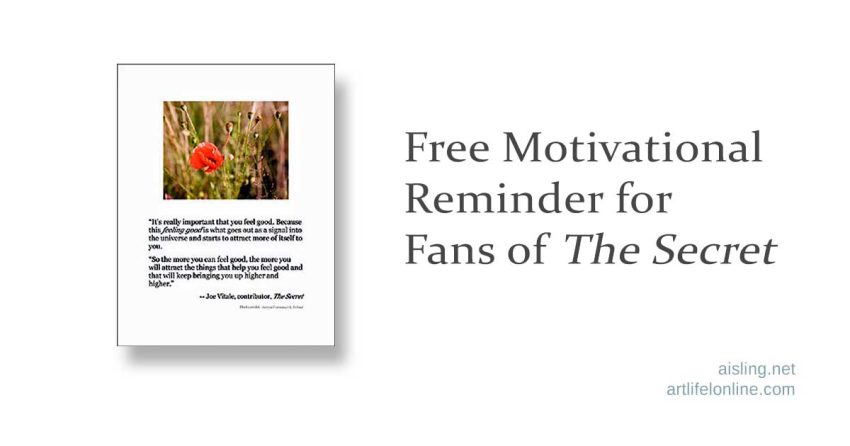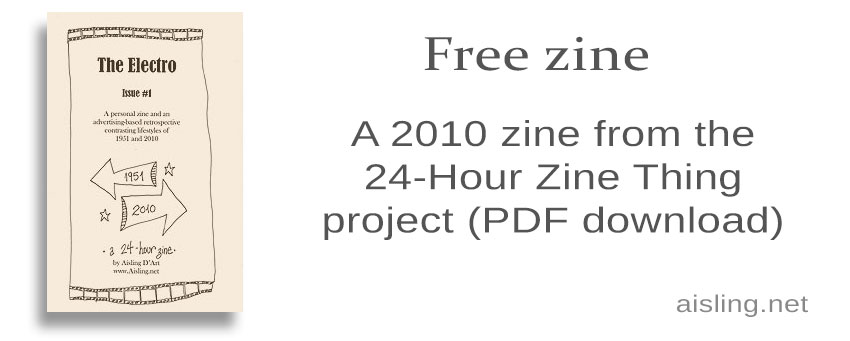When I create anything artistic, I feel good. I’ve also noticed that my life goes better… I attract more good things into my life. So, when Bob Proctor sent me this quotation this morning, I knew I wanted to turn it into a mini-poster and put it on my wall. The quotation is: “It’s really…
Author: Aisling
24-Hour Zine – Download
Looking for a FREE zine? Here’s one of mine. It’s from 2010’s “24-Hour Zine Thing” project. You can download this zine, page-by-page, and assemble it yourself. (It’s easy. Really.) What’s a 24-hour zine? During July 2010, participants had to go from concept to printed/bound zine in 24 hours or less, and the zine had to…
24-Page Zine Layout – How to Make a Zine
The first time you try a zine layout, I know it can be confusing. And frustrating. But I’m about to show you how to put your zine pages together so they’re in the right order in the finished zine. I’ve been creating zines for over 30 years, and I still sketch my zine layout on…
Sock Doll Swap – Jul 2010
A sock doll swap is an exchange of dolls made from socks. In this 2010 Wild Art Dolls exchange, the dolls had to be made from socks and three of them had to fit inside a flat-rate Priority Mail envelope. Three of us participated. Here are some of the dolls: My dolls were almost identical….
24-Hour Zine Thing – What I Learned
Concluding yesterday’s 24-page, 24-hour zine, I learned a lot. (Here’s the link to the printable zine: 24-hour zine download.) I’m still not sure if I’m going to try a second one for this challenge. Probably not. (If I had more time, I might. With just two non-weekend days left in the month, it’s probably not…
Zines – My 24-Hour Zine Thing Diary
Today, I’m starting the 24-hour zine thing. (Yes, that’s what it’s called.) This may be quite a challenge! What is a 24-hour zine? If you’re not familiar with it, here’s the basic idea: Go from concept to completed/printed-and-bound 24-page zine in 24 hours. My general plan is to start it around 1 p.m. today. I’m…
Choosing Fabric for Your Cloth Doll
The first rule of cloth doll making is: BREAK THE RULES! Nobody said the skin fabric has to be pink. Or muslin. Or brown. Or whatever. Your doll’s skin can be purple. Or green. Or paisley. Or white lace over silver lame that you’ve fused to muslin. Nobody said that your dolls’ legs and arms…
Cloth Dolls – How to Choose the Best Doll Stuffing
Not sure how to choose the right cloth doll stuffing? Here’s the punch line: Buy the best doll stuffing (ex: fiberfill, polyfill, batting, cotton wool) that you can afford. The cheap stuff may look the same in the bag. It may even feel the same if you squeeze it. You may think, “I’ll bet this…
Cloth Dolls – Should You Preshrink Fabrics
Should you preshrink fabrics (or prewash them) before making a cloth doll? Yes… and no. It depends upon what’s important to you. Why not to prewash or preshrink fabrics Fabrics, especially cottons, never look quite so “fresh” after prewashing. The sizing* and surface finish wash off, so the fabric doesn’t look as smooth. In most…
Swaps and Documentation
Some swaps say, “Documentation will be provided,” or something like that. Here’s what that means: The person organizing the swap will provide a list of everyone who participated in the swap, mailart call, or whatever. In some cases, that list may be just people’s names. In others, it’s each person’s name and address. (If you…



